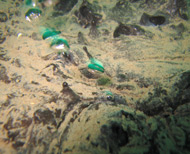甲烷的危机
|
Deep trouble. 背景资料 以往我们一听到温室效应,第一直觉都会联想到二氧化碳。但是越来越多的研究指出,甲烷对温室效应的影响,是超乎我们之前所想像的。加州大学专门研究古老海洋地质学家Tessa Hill等从观察圣巴巴拉市(Santa Barbara)周围海洋底部沉积物之后发现了这个问题。 Marine Methane Heats Things UpBy Julie Rehmeyer Bedrock below the ocean bottom keeps a lid on oil reservoirs, but it's not an impermeable cap. Small cracks allow petroleum and methane to bubble to the surface. Once there, the petroleum oxidizes and turns to tar, which sinks. Meanwhile, the methane drifts into the atmosphere, where it makes up about 15% of the total amount of the gas sent skyward by natural sources such as wetlands and melting tundra. Humans contribute slightly more than all natural sources combined. But does undersea methane make up a larger piece of the pie during periods of global warming? Paleo-oceanographers Tessa Hill of the University of California (UC), Davis, James Kennett of UC Santa Barbara, and collaborators attacked the question by looking at tar deposits from sediment cores taken off the Santa Barbara coast. They found 3 times more tar mixed into the sand from the last two major warming periods, 11,000 and 15,000 years ago, than was seen on average. This suggests that 3 times more oil was released from seeps during those periods, and 3 times more methane along with it, the team reports online this week in Proceeding of the National Academy of Sciences. The team suggests that global warming may have first melted undersea methane ice, disturbing the sea floor and opening new cracks in the oil reservoirs. "This is a source of methane that we might have assumed in the past was stable," says Hill. "As it turns out, it's very sensitive to climate change. I would anticipate that it would be sensitive to climate change in the future as well." If methane was released similarly from all the other marine reservoirs worldwide, it would account for nearly half the increase in atmospheric methane during those warming periods, says Hill, who believes this methane may have driven further warming. The researchers acknowledge, however, that global warming would probably affect different petroleum deposits differently, so such a simultaneous release is unlikely; further research will be needed at other oil seeps around the world, they say. The evidence from Santa Barbara is "beautiful," says Jérôme Chappellaz, an atmospheric scientist at the Laboratoire de Glaciologie et Géophysique de l'Environnement in St Martin d'Hères Cedex, France. But he cautions against extrapolating to all marine oil reservoirs around the world. Evidence from carbon testing of ice core samples points away from marine methane sources and toward wetlands and melting tundra, he says. |









